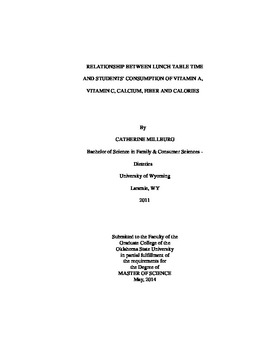| dc.contributor.advisor | Hildebrand, Deana | |
| dc.contributor.author | Millburg, Catherine Leah | |
| dc.date.accessioned | 2015-06-17T20:07:04Z | |
| dc.date.available | 2015-06-17T20:07:04Z | |
| dc.date.issued | 2014-05-01 | |
| dc.identifier.uri | https://hdl.handle.net/11244/15012 | |
| dc.description.abstract | Advocacy groups recommend the length of the school lunch period be appropriate to allow students 20 minutes of table times, but there is limited scientific evidence to support the recommendation. The purpose of this study was to determine whether students who received more table time would consume more of the energy and select shortfall nutrients provided by the reimbursable school lunch. Table time was calculated by subtracting the time that the children exited the meal service line from the time that the children were dismissed from the table. A three-day plate waste study and nutrient analysis was conducted to identify food and nutrient consumption (i.e., total calories, vitamins A and C, fiber, and calcium). It was hypothesized that those students who had more table time would consume more nutrients. An independent sample t-test compared students' table time. Students who exited the meal service line first received significantly more table time (mean = 17.8, SD = 1.8) than those who exited the meal service line last (mean = 12.4, SD = 1.8, p ≤0.001). A Pearson correlation analysis revealed positive correlation between table time and the amount of vitamin C and fiber consumed by students. A t-test was used to compare students with the longest table time to the National School Lunch Program nutrient standards for calories and each of the nutrients of interest. The analysis revealed the students with the most table time were not consuming enough food to meet the fiber, calcium or total calories standards for the school lunch program. Further research is needed to determine the amount of table time students need to meet the one-third RDA for shortfall nutrients and calories, and identify other factors that might be limiting food consumption in the school cafeteria. | |
| dc.format | application/pdf | |
| dc.language | en_US | |
| dc.publisher | Oklahoma State University | |
| dc.rights | Copyright is held by the author who has granted the Oklahoma State University Library the non-exclusive right to share this material in its institutional repository. Contact Digital Library Services at lib-dls@okstate.edu or 405-744-9161 for the permission policy on the use, reproduction or distribution of this material. | |
| dc.title | Relationship Between Lunch Table Time and Students' Consumption of Vitamin a, Vitamin C, Calcium, Fiber and Calories | |
| dc.type | text | |
| dc.contributor.committeeMember | Betts, Nancy M. | |
| dc.contributor.committeeMember | Gates, Gail | |
| osu.filename | Millburg_okstate_0664M_13197.pdf | |
| osu.accesstype | Open Access | |
| dc.description.department | Nutritional Science | |
| dc.type.genre | Thesis | |
| dc.subject.keywords | calcium | |
| dc.subject.keywords | calores | |
| dc.subject.keywords | fiber | |
| dc.subject.keywords | school lunch | |
| dc.subject.keywords | vitamin a | |
| dc.subject.keywords | vitamin c | |
